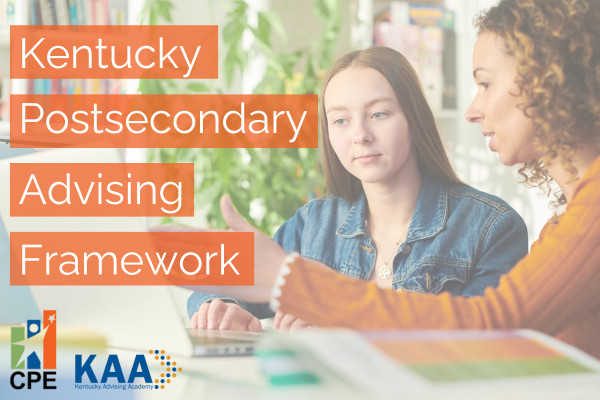What Does the Future of Postsecondary Advising Look Like? Kentucky Has a Plan.

Co-author: Danesha Ward
“In the wise choice of a vocation, there are three broad factors: a clear understanding of yourself (your aptitudes, abilities, and interests), knowledge of the requirements of different lines of work, and the ability to reason the relationship between the two.”
These are the words of Frank Parsons, the father of vocational guidance. At the turn of the 20th century, Parsons was at the forefront of a movement to help young people navigate a new post-Industrial Revolution economic landscape. His work was pivotal in emphasizing the importance of aligning individuals’ abilities and skills with careers that would “bring life sustaining wages and career fulfillment.”
Today, a century later, we find ourselves in the midst of another economic and educational transformation, driven by a focus on career-connected learning and the movement away from Industrial and toward Information. Just as Parsons advocated for vocational guidance in an era of unprecedented change, we now need more than ever, an aligned approach to postsecondary advising to help students successfully transition from K-12 education to higher education and ultimately the workforce.
Leading the way in this effort is the state of Kentucky’s Council for Postsecondary Education (CPE). Kentucky has made notable strides in improving postsecondary outcomes, signaling progress in postsecondary readiness and access. Enrollment at the Kentucky Community and Technical College System (KCTCS) increased by 6.5% from fall 2022 to fall 2023, reaching 78,771 students. Similarly, undergraduate enrollment at public universities grew by 1.6% during the same period. Retention rates also hit new milestones, with public universities surpassing an 80% average for the first time (80.7%) and KCTCS achieving a retention rate of 60.8%. Additionally, the percentage of Kentucky’s high school graduates enrolling directly in college rose to 53.3% in 2022, up from 51.5% the previous year.
These trends underscore the critical importance of initiatives like the Kentucky Advising Academy (KAA), an initiative of CPE, which seeks to promote high-quality postsecondary advising across the state by providing resources, training, and tools to school counselors and advisors. ESG has been a proud partner of the KAA, helping to build useful and usable materials that seek to answer for school counselors and advisors, “What should students know about college and career?” “What should students be doing to support college and career decision-making?
For example, the Kentucky Postsecondary Advising Framework provides key milestones and suggested college and career related activities for students in grades 6-12—across four domains: career exploration, postsecondary opportunities, financial aid and literacy, and essential skills—to prepare students for the transition to postsecondary education and the workforce.
The Framework was the direct result of deep engagement and conversation with Kentucky school counselors, principals, college and career coaches, career and technical education administrators, the Kentucky School Counseling Association, GEAR UP, the Kentucky Department of Education, and other key advising organizations to gather insights on the existing work they are doing to promote high-quality advising and understand from the educator’s perspective the information and experiences that students should have at each grade level from 6-12. Building on those conversations and the needs that were articulated from practitioners, ESG identified exemplary resources from other states who have done deep work to map key advising milestones (e.g. Colorado’s career conversations, Illinois’ PACE framework, etc.), and from professional organizations like the American School Counselor Association (ASCA) and the National College Attainment Network (NCAN), to truly understand where there are strengths, and where there are gaps, in the way postsecondary advising is deployed and the actions and knowledge that we know students need to make informed decisions.
The intention of this rigorous design approach was to ensure that no matter who picks the framework up, it will have a clear and meaningful impact on practice. If the ultimate goal is to provide better guidance to students to help them to succeed in their academic and professional endeavors, then we need to dramatically grow the number of individuals and organizations that are helping youth explore and navigate their pathways.
KAA recognized that effective implementation of the framework at a systems level must acknowledge and respect the fact that some districts and schools might want or need more targeted support. Through webinars, the KAA introduced the framework to educators and advisors across the state, ensuring a clear understanding of its goals and intended outcomes. Additionally, participation in in-state conferences such as the Kentucky Career and Technical Education Conference has allowed the KAA to engage directly with stakeholders, fostering collaboration and gathering feedback on the framework. The piloting of the framework with a representative group of OneGoal districts—a partnership that the state has invested in as part of their broader advising and CCR strategy—has been particularly impactful, offering valuable insights into real-world application and informing continuous improvement for wider-scale implementation.
Kentucky is committed to a vision that ensures that students are informed and empowered to make decisions that align with their strengths and aspirations. Much like Parsons’ early focus on vocational guidance, Kentucky’s framework stands as a catalyst for aligning expectations for postsecondary advising and addressing the foundational needs of students as we prepare them for transition to higher education and the workforce.
As postsecondary pathways to success become increasingly diverse, the need for states to adopt comprehensive advising frameworks has never been more urgent. The Kentucky Postsecondary Advising Framework exemplifies how states can create a seamless advising system that promotes preparedness for postsecondary decision-making for all students. Through frameworks like this, states can foster collaboration across schools, districts, higher education institutions, and community partners, ensuring that all students have a clear path toward achieving their goals.



